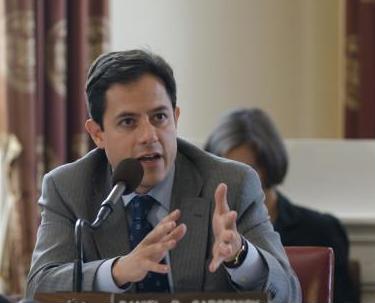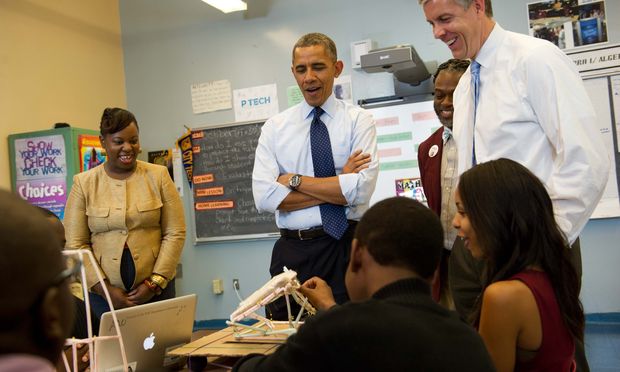New York's Uncovered Crisis
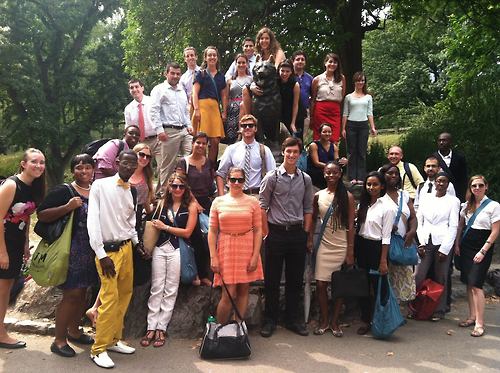
Fellows in a city job-training program (nyc.gov)
We all hear about how hard it is for young adults to get a decent job in New York City. Popular TV shows and news stories usually focus on college graduates with great grades and connections being forced to take unpaid internships to get a foot in the door. But the youth unemployment crisis is far more extensive and dire than often depicted. Nationwide, 6.7 million young adults ages 18 to 24 are neither in school nor working; 172,000 live right here in New York City. Many of them lack a high school credential and have limited work experience, making the task of getting a job even more challenging.
New York State partnered with four other states and the District of Columbia to try and address this crisis by developing the National Work Readiness Credential (NWRC). The well-intentioned goal was a common credential to show employers that a jobseeker could perform well in an entry-level position. According to an investigative report by JobsFirstNYC, however, few of the tens of thousands of young people who tried to earn the NWRC attained it. Only 312 young adults in New York City secured the credential in 2011, out of an estimated 12,000 who prepared for it. The few who earned the credential gain no benefit in getting a job, because employers do not recognize the NWRC. Black test takers fail the NWRC exam at twice the rate of whites, suggesting the test is racially biased.
The test for the NWRC fails to measure the skills needed for the service and retail jobs sought by most unemployed young adults in New York City. Some questions are taken directly from the New York State Trooper entrance exam, which requires a driver's license and at least two years of college. Other questions require knowledge of office and warehouse operations. These questions have nothing to do with the skills that most young people need to perform on the job. The test was not found valid for young adults and non-white populations, the very same persons to whom the test is now administered.
Because the test doesn't measure the skills they seek, employers do not recognize the NWRC. Of over 100 New York City employers surveyed by JobsFirstNYC, none asked candidates if they had the credential. Consequently, the hiring rate for the few individuals with the credential is virtually identical to the hiring rate of those without it.
New York State is fully aware of these deficiencies, but has made this ineffective credential a key component of its youth employment programs - at a potential cost of millions. Job training providers statewide are required to spend weeks preparing their participants for the qualifying exam. The State's costly promotion of the NWRC despite its nonexistent benefit to young job-seekers and apparent racial bias, diverts resources away from programs proven to get young adults into the workforce.
So what should New York State be doing instead? Thousands of well-paying jobs are available in New York City that can be performed without a four-year college degree. Young adults can become cable installers, computer technicians, and truck drivers, for example, by earning employer-recognized postsecondary certificates. Employers can develop and implement high-quality on-the-job training that meets their needs.
JobsFirstNYC and our partners connect service providers and sectoral employers to create customized training to meet industry-specific demands. Programs like these enable young adults to acquire industry-recognized credentials, as well as work experience leading to good jobs. Strategies that help workforce development organizations respond to labor market demands in growth sectors of the economy are proven to increase employment of individuals with limited education.
There is currently no State support for such employer-driven workforce development programs, despite reports that employers in many of the City's economic sectors are having difficulty filling openings.
Forcing young adults in New York City to take a test they will likely fail when they already confront tremendous barriers in entering the workforce is counterproductive and interferes with efforts to improve their skills and get a good job. New York State needs to drop the National Work Readiness Credential and put resources instead in programs proven to help young people get and keep decent-paying, good quality jobs.
***
Louis Miceli is Executive Director of JobsFirstNYC, a nonprofit focused on connecting young adults to the economic life of New York City.
Philosophers or Bullies?
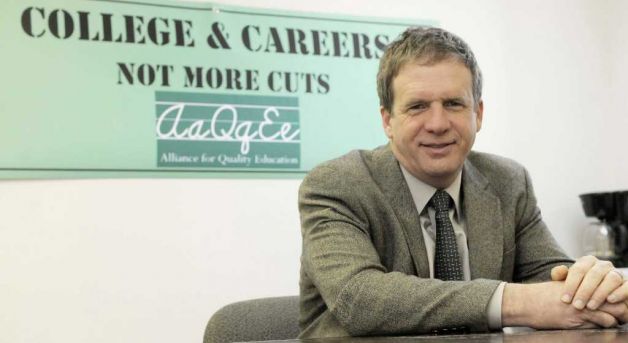
The author, Billy Easton (Times Union)
The future of public education looks frightening under Governor Cuomo.
The Governor has completely abandoned his obligation to adequately fund public schools—and this weekend, he will travel up to Lake Placid to "reform, relax, and retreat" at Camp Philos, a "philosopher's camp" on education.
Real philosophers, like Ralph Waldo Emerson, who retreated into those same woods 150 years ago, believed in a well-rounded education system that would be fully funded by the state.
But in our modern day, when it comes to public schools, retreating and relaxing is a privilege that parents, students and teachers in severely underfunded public schools across the state just don't have.
So what is this all really about?
Camp Philos is really more of a private resort for the wealthy and powerful corporate education reformers—tickets cost a whopping $1,000 each (for VIPs $2,500). It's a chance to plot and scheme about how to control the direction of education in New York State and the nation; and they just may have the money to do it.
Governor Cuomo will be the honorary chairman of Camp Philos, and next month he will be honored by a charter advocacy group in D.C. as the national "Charter Champion." These "honors" are well deserved, in the Orwellian sense, following a state budget session where Cuomo proposed to underfund traditional public schools that serve 97% of students. At the same time, he aggressively drove more resources and special privileges to charter schools that serve a mere 3% of students across the state.
This honor allows Cuomo to cash-in on the lucrative campaign donations of ideologically-motivated bankrollers of the corporate education reform agenda; people like Ken Langone, chairman of Republicans for Cuomo, who gave the Governor $50,000 and has raised much more. This is the same crowd that just spent more than $5 million on TV advertising and lobbyists to bully the legislature into submission as Governor Cuomo carried their water on education.
While backers of the corporate school agenda are proclaiming Cuomo as a conquering hero, public school parents around the state are protesting against him. His policies have systematically forced classroom cuts every year he has been in office and have promoted a damaging culture of teaching to the test. Under his watch New York State schools have dropped from 8th to 20th in K-12 Achievement, according to Education Week, the nation's leading education periodical.
The organizers of Camp Philos are literally bathing in money from hedge fund managers and other super-wealthy donors that are ready to continue arming the Governor in his effort to push forward more corporate-style reforms for our schools. These reforms do absolutely nothing to improve teaching and learning at the majority of public schools across the state. Instead, they aim to increase testing, expand privately-run charter schools, punish schools instead of improving them, and take parents out the equation of improving schools.
This corporate reform agenda is based on competition and bottom-lining schools, students and teachers the way you would a balance sheet. It is the completely wrong direction for education in our state, but the Governor insists on getting our children lost deeper in the woods.
Meanwhile, our public schools are barely scraping by. Year after year, school districts across the state have been put through an endless cycle of classroom cuts that have resulted in shrinking opportunities for students. The result is less art, music, gym, afterschool programs, and Advanced Placement courses for students—all while increasing the amount of test-prep and testing.
Basically, while becoming Chief Philosopher of Camp Philos, Governor Cuomo has kicked the Campaign for Fiscal Equity to the curb, even though the state's highest court established that billions of classroom dollars were needed for students, especially those with the highest need.
This out-of-touch attitude for public education is no surprise, considering he has not toured a single public school since taking office.
Here's a solution: instead of hanging out with the corporate reform crowd collecting campaign cash, Governor Cuomo should visit a neglected and underfunded rural school, or an overcrowded urban school and ask students to grade his education policies.
***
by Billy Easton, Executive Director of the Alliance for Quality Education
Restoring Sanity to Student Promotion Decisions
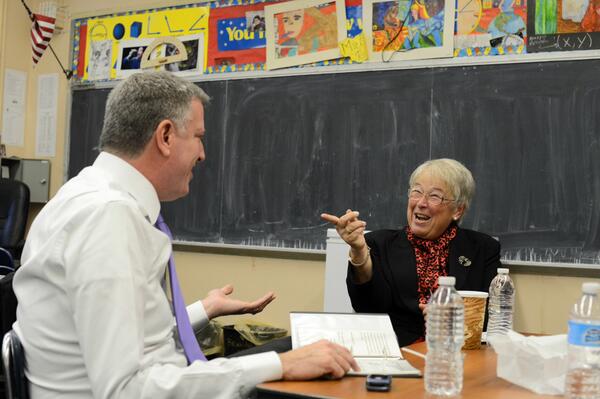
Mayor Bill de Blasio and schools Chancellor Carmen Fariña (@NYCTransition)
Two weeks ago, Chancellor Fariña introduced a major education policy change. Students in grades 3-8 will be assessed for promotion by "the integrated use of multiple criteria" equivalent to an achievement portfolio, and "State test scores may not be the primary or major factor in promotion decisions." This policy replaces the Bloomberg fantasy that holding students back is a useful solution to our systemic education problems.
Ten years ago Mayor Michael Bloomberg and Schools Chancellor Joel Klein announced a new student promotion policy based on retention – holding students back in the 3rd grade based on their New York State test results. The mayor and chancellor trumpeted this tough love approach as a system to improve students' outcomes and strengthen academic standards across the city's schools.
This new retention policy generated a maelstrom of protest. Opponents cited decades of research demonstrating that holding students back encourages academic failure and dropping out, and argued that standardized tests were not designed to assess individual students' readiness for promotion. But the mayor and the chancellor were undeterred. They submitted their end-social-promotion policy to the Panel for Educational Policy, and when three panel members declared they would vote against it, the mayor engineered their removal before the vote.
Eight years later, in June, 2012, the Bloomberg administration quietly decided roll back it's approach. The administration's 2012 revision of its retention policy gave principals discretion to promote 3rd through 7th-graders who'd been held back multiple times or were significantly over-age for their grade – a covert admission that the get-tough policy wasn't working.
Retention numbers tell a similar story. In the 2003-04 school year, some 3,600 3rd graders were held back. In 2008-09, the last year I could find references to specific numbers of students retained, some 480 3rd graders were held back, a decrease of almost 750%.
Some of this huge decrease was due to a rise in test scores, however ultimately spurious they were, and a corresponding drop in the numbers of students targeted for retention. But most of the decrease was due to the decisions of frontline educators who stretched the limited discretion written into the end-social-promotion policy on behalf of 3rd graders who, in their professional view, should not be held back.
Chancellor Fariña's new promotion standards justifies, and retrospectively honors, all those teachers and principals who used the loopholes in Bloomberg's get-tough policy to demonstrate that student achievement and capacity cannot be usefully assessed by standardized tests, and that holding students back cannot contribute to their educational growth. The new policy mandates the use of a range of assessment measures that respond to the diversity of students' learning capacities, such as a student's body of work over the span of an entire year.
Thanks to this advance, the New York City school system now has the opportunity not only to restore sanity to promotion/retention decisions, but to tackle the core questions of how best to assess our students' academic achievement and, most important, how to improve their outcomes.
***
by Norm Fruchter, senior scholar at the Annenberg Institute for School Reform and a mayoral appointee to the NYC Board of Education, colloquially known as the Panel for Educational Policy (PEP)
De Blasio's Next Move on Charters

Mayor de Blasio reads to a pre-k class (nyc.gov)
An analysis of the new State charter school siting law demonstrates that the City has the ability to decide, as a regular practice, to purchase or rent charter facilities instead of engaging in endless co-location battles. This would enable the Mayor to keep his campaign promise to tamp down co-locations while appeasing charter advocates who backed the new law.
Despite a widespread assumption that the City can only offer off-site space if co-location is impossible, the recently enacted State statute on co-locations requires the charter school to request co-location but gives the City an equal option of responding either with a proposed co-located site or a non-Department of Education private or public building.
The law even opens to question whether such a decision by the City is appealable (the appeals provision only refers to "co-location"), but assuming a charter's right to appeal an off-site decision, the standard of appellate review favors the City, as clearly stated in recent court decisions holding as reasonable Mayor Bloomberg's charter co-location decisions. Those cases were misunderstood as charter victories, but their real importance is that they upheld the city's discretionary authority to determine charter sites. Under the law, reversing such a decision requires a finding that the city's proposal was "arbitrary and capricious," a very high standard for charters to meet. The new statute explicitly incorporates that standard.
As a result, the City could successfully defend a good faith off-site offer without charter acquiescence. But why wouldn't a charter prefer independent space, especially given all of the tension over space sharing and district school displacement? I'm foreseeing deals in which the charters will agree; move into their own sites, free and clear without co-location hassles and with School Construction Authority renovations thrown in!
Where co-location arrangements make sense in schools without future over-crowding or other instructional detriments, such decisions would be financially preferable. But the governor and Legislature created the payment obligation, so any mayoral decision to cover charter rental costs instead of co-locating should be laid at the State's door, not the City's. And the City's sole share is limited to a $40 million ceiling, after which a State contribution is triggered with federal charter school aid also likely to be available.
.
While the $40+ million in possible rental payments are attributable to the City's annual expense budget, purchase or renovations are capital items. Remember the new administration's cut of $210 million in the capital budget that Bloomberg had earmarked for off-site charters, arguably the action that set off this real estate scramble? That previously committed money is still available and, if the editorial pages didn't object to Bloomberg's handing it over to charters, they can hardly object to de Blasio's pressured re-allocation.
A further reason for highlighting the mayor's discretionary siting power, one of the few he actually has over charters since their operations are intentionally out of the hands of the mayor and chancellor, is the likelihood that school space will soon become scarcer. Will we suddenly demolish a bunch of buildings? No. But the mayor has a commission, working behind the scenes, which will soon recommend changes in the usage formula used for calculating school overcrowding, known as the Blue Book. The old formula, which Bloomberg used to justify spaces for charter co-locations, is likely to be recalibrated to require more space per child plus the need for libraries and art spaces, significantly lowering the threshold at which a school is designated fully enrolled. Add to that a promised decrease in class size and the need for pre-k space. Poof!, an immediate and significant decrease in available space for co-located charter or traditional public schools.
As politicians, budget experts, and lawyers toil over the intricacies of school siting under the State's new rules, it is to be hoped that educators, parents, and students are allowed a voice in these determinations. If so, a new spirit of cooperation, if not co-location, may result.
***
David C. Bloomfield is Professor of Leadership, Law, and Policy at Brooklyn College and the CUNY Graduate Center; contact: This email address is being protected from spambots. You need JavaScript enabled to view it.
***
The statute in pertinent part, at NYS Education Law § 2853(3)(E)(1), requires the city to "(A) offer at no cost to the charter school a co-location site in a public school building . . . or (B) offer the charter school space in a privately owned or other publicly owned facility at the expense of the City School District and a no cost to the charter school. The space must be reasonable, appropriate, and comparable and in the community school district to be served by the charter school and otherwise in reasonable proximity."
***
[Have an op-ed submission? Send it to Gotham Gazette executive editor Ben Max: This email address is being protected from spambots. You need JavaScript enabled to view it.]
The Next 100 Days
(schools.nyc.gov)
To be fair, as much as pundits and talking heads like to focus on an elected official's "first 100 days" in office, 100 days is not a very long time. Mayor de Blasio and Chancellor Fariña can't be expected to have fully eradicated poverty in New York City or turned around every failing school in such a short timeframe. But we can expect them to offer a vision for improving public education, along with concrete ideas about how to make schools tangibly better for students.
In place of specifics, the mayor and chancellor gave speeches to mark their first 100 days that were heavy on rhetoric and light on substance. The mayor parroted UFT talking points – inaccurately at that – and exaggerated a teacher retention crisis to lay the groundwork for large teacher raises. The chancellor, in a 17-page speech, offered not a single solution to improve struggling schools. In place of specifics, she offered vague references to increasing joy and collaboration. To be clear, we are also pro-joy and collaboration, but we need real solutions to the real challenges facing our schools.
With the first 100 days behind us, it's time to look forward. What can the mayor and chancellor do over the next 100 days and 100 weeks to ensure that every child in New York City has access to a high quality public education?
Over the next 100 days, the de Blasio administration will engage in a process that will have a direct and profound impact on the course of New York City schools for years to come. The City and the United Federation of Teachers (UFT) will hammer out the details of a new teachers contract that will serve as a blueprint for how the mayor plans to shape public education. The mayor should use this opportunity to focus on retaining and rewarding great teachers and getting rid of ineffective teachers.
StudentsFirstNY understands that a great education starts with great teachers. That's why we support higher pay for teachers and we encourage the administration to negotiate a contract that treats teachers like the professionals they are. In order to retain the best, the City should increase pay for highly effective early career teachers. Paying good teachers more money will help attract more talented candidates to the profession and encourage those currently in classrooms to continue their careers in New York City public schools. We can pay for this increase by eliminating incentives that have nothing to do with effectiveness – like salary increases for extra courses that don't impact teaching quality.
While we're investing in effective teachers, we should make sure that ineffective teachers show tangible improvements or leave the system. The City currently pays approximately 1,200 teachers in the Absent Teacher Reserve (ATR) pool $144 million per year not to teach full time. Many of these ineffective teachers have disciplinary records and few actively look for new positions. We should stop paying these people not to teach, but rather than force them back into classrooms – as the UFT is pushing to do – we should set a time limit for the ATR pool. If an ineffective teacher goes an entire year without finding placement in one of the thousands of open positions, it's time for that person to move on to a new profession.
Based on their rhetoric over the first 100 days, it seems like the mayor and chancellor believe that our school system's chronic problems can be solved by more collegiality and less academic rigor. This comes up woefully short of what it will take to make schools better for the hundreds of thousands of struggling students this system is failing each year.
We hope that the next 100 days will bring more specific plans of action, and we strongly encourage the mayor and chancellor to focus their efforts on a new teachers contract that values outstanding teachers, protects our kids from ineffective ones, and provides city students with the high-quality instruction they need to be successful in school and beyond.
***
Jenny Sedlis is the Executive Director of StudentsFirstNY
Park Equity Begins with a Better Public Budget

(NY4P.org)
An early springtime sun was shining down on Seward Park as Mayor de Blasio introduced Mitchell Silver as New York City's next parks commissioner last month on the Lower East Side. It was an inspiring day for park advocates across the city, as both the mayor and incoming commissioner offered thoughtful, even-handed commentary centered on a clear goal: a fairer park system for all New Yorkers.
Now, with budget season upon us, we're pleased to see that the mayor's preliminary budget for parks not only baselines many of the important restorations made over the past few years, such as street-tree care and stump removal, but funds items up front that are usually subject to the annual budget dance, such as Playground Associates and seasonal workers to staff pools, among other facilities.
This good news gives the parks community the opportunity to turn its attention to the larger issue of addressing inequities across the park system – including at a city council hearing next Wednesday, April 23rd. The solution is complex and nuanced. While many of the large park conservancies are ready to work with the commissioner on bringing more private resources – financial and otherwise – to parks in need, it's clear, as council parks and recreation committee chair Mark Levine noted recently in the Huffington Post, that addressing inequities must begin with the public budget. There are several specific budget and policy reforms that the administration and its Department of Parks and Recreation (DPR) can undertake in the name of equity and fairness.
Expense budget
On the expense side, fostering greater equity will require addressing the top concern of many local park advocates across the city: there simply isn't enough full-time staff assigned to the parks that need them most. Rather, 75 percent of DPR's maintenance staff is made up of Job Training Participants (JTP) who work at DPR up to six months but are almost never given an opportunity for permanent employment once their training is complete. "Almost as soon as they're really up to speed on the park, they cycle out," a local advocate told us recently. Her comment rings true across the city.
At the same time, many advocates tell us that having full-time staff – a familiar face in the park – goes a long way toward improving the overall park experience for users. These issues offer Mayor de Blasio and Commissioner Silver an opportunity to both address park equity issues and create good entry-level jobs.
What would those jobs be, where would they make the most immediate impact, and how much money is needed to create them? A good place to start would be to create a neighborhood parks fund of $10 million, which would allow Commissioner Silver to work with the Council on a plan that really starts to address needs in underserved parks. Here are a few ways such a fund could be spent in high-need areas:
- $4 million for 100 full-time workers to staff playgrounds with comfort stations.
- $3 million for 50 skilled full-time gardeners to help maintain midsized neighborhood parks.
Our organization learned first-hand how important these positions are when we helped lead the Neighborhood Parks Initiative almost 10 years ago.
Not only would these new positions start making a difference for parks most in need right away, but they'd offer an opportunity for DPR's part-time workers to gain full-time employment through a new, robust training program to help transition JTP staff into full-time maintenance workers and gardeners.
- $3 million for park-tree pruning and stump removal. Though DPR has shortened its street-tree pruning cycle thanks to recent budget restorations, it still prunes very few park trees.
- $2 million would allow DPR to prune at least about 25,000 trees in parks: a good start toward a pruning cycle.
- An additional million dollars would allow DPR to remove approximately 4,000 more stumps.
Capital budget
There is also an opportunity to address park inequities through the capital budget. In recent years, the Department of Parks and Recreation has not had a meaningful discretionary budget to really enable it to plan for and fund capital projects over time across parks citywide. Rather, DPR has been reliant for funding for the majority of its projects on piecemeal discretionary allocations from city council members and borough presidents. Cobbling together allocations over multiple fiscal years from different elected officials is inefficient, leads to inequitable results, and often means the nuts-and-bolts needs of parks across the city fall through the cracks.
We are pleased to see that our call for increased discretionary capital funding, as highlighted in our Parks Platform 2013, seems to have been heard: the initial fiscal year 2015 budget contains a significant amount of capital funding for parks, and it appears to be at the discretion of Commissioner Silver. We call on the Council and administration to ensure that this funding remains in the final budget. At the same time, our recent research on improving the timeliness of capital construction shows that funding should be added to the budget for additional full-time positions in the capital division.
The introduction of Mitchell Silver, an urban planner, ushered in a new era not only for New York City's parks, but for its neighborhoods. After all, parks lie at the heart of city neighborhood life, in every corner of each borough – infrastructure as essential as housing, sewer lines and roads. The community building impact these spaces have extends far beyond their boundaries. Park issues are neighborhood issues.
As Commissioner Silver takes office, we're hopeful the administration and Council will supply him with the budgetary tools needed to really address inequity – and, in turn, lift the park system as a whole.
***
Tupper Thomas is the Executive Director of New Yorkers for Parks, an independent research and advocacy organization.
Preliminary Budget Questions Remain
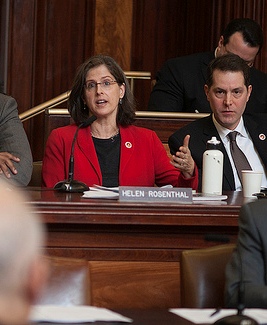
Council Member Helen Rosenthal (William Alitriste)
I have always been fascinated by quantifying public policy and the very practical details of implementation. Diving into the details, one can learn if public dollars are being spent wisely and efficiently or not.
March madness for the Council is the near daily set of hearings with each city agency to review their budgets. These hearings can last hours as council members try to decipher what agencies are spending their money on and whether or not the agency needs more or less funding to provide adequate city services.
I view the City's $73 billion expense budget as a concrete reflection of the City's public policy. The broad brush "progressive" goals are to address income inequality; every tax dollar spent should be geared toward stabilizing the middle class and helping those who depend on government services. Toward this end, lots of questions were raised during the March Preliminary Budget Hearings, and we're still waiting for the answers.
For example: How much is the City investing in Minority & Women-Owned Business Enterprise (M/WBE) training programs? What industries does Economic Development Corporation (EDC) plan to invest in to support middle-wage workers?
I also have serious questions about the contracts issued through the Department of Education (DOE) Central Administration. Are contracts that, in sum, cost over $115 million good investments? For all technology investments, are we paying outside contractors to do day-to-day work, or are they setting up systems then training city workers to implement programs? How can DOE do a better job billing Medicaid for special education services? Right now, 75% of our DOE special education expenditures could be paid for by the state and federal governments, and we lose millions every year by under-billing.
And, why is the Department of Homeless Services (DHS) spending $3,600 per month for each adult couple for a single room and shared bathroom with minimal social services? How can we provide the service without paying the Single Room Occupancy (SRO) landlords so much money? Can the Department of Housing Preservation and Development (HPD) find funds to reverse their downsizing policy, which has been moving elderly seniors out of their homes (and traumatizing them in the process)? Why is the New York City Housing Authority (NYCHA) spending millions of dollars on temporary home-heating boilers that don't work below 40 degrees?
While the City Council develops its response to the mayor's budget, my hope is that each of the agencies will take our questions into consideration as they prepare for the Executive Budget (due in May). As I made clear to the Director for the Office of Management and Budget (OMB), I expect the Mayor's May budget to reflect the Administration's public policy to address income inequality.
Council Member Helen Rosenthal represents District 6 (Upper West Side) and is Chair of the Contracts Committee. Rosenthal is a member of the Council's Budget Negotiation Team and was recently elected Vice Chair for Budget in the Progressive Caucus.
The opinions written here are her own and are a reflection of her seven years work experience in the NYC Office of Management and Budget.
What’s Next for East Midtown
Council Member Dan Garodnick (D-Manhattan)
There was a lot of talk last year about the urgent need to rejuvenate East Midtown.
Mayor Bloomberg offered a serious, but incomplete, rezoning proposal. Too many questions remained about the improvements to Grand Central's infrastructure and the pricing of air rights to advance new development. The ball is now in Mayor de Blasio's court, and we hope he will run with it.
The need for action results from antiquated zoning rules which trap buildings in their current condition. Today, someone who tears down their building can only build back to the same size if they retain 25 percent of their structure. The economics of those regulations leaves few developers willing to terminate leases, vacate buildings, demolish, and rebuild. One early concept simply allowed those buildings to rebuild up to their current densities, essentially "grandfathering" them in.
The rezoning proposal that emerged, however, added even more density by allowing developers to purchase air rights at $250/foot, to be used to finance local infrastructure. While it allowed for the purchase of air rights, it unwisely set the price of those air rights the same across an 80 block territory. It committed considerable sums for infrastructure, but without certainty that they would be used for the most needed improvements. At our insistence, a public realm plan was proposed, but it was unclear if many of the recommendations could actually be implemented. In short, the goals were laudable, but for a plan that would take effect over decades, we needed more time to get it right.
Now we can. We have an opportunity to create the right environment to allow East Midtown to keep its competitive edge. As we devise a new plan, we should consider why companies will want to locate in East Midtown over the next 50 years, and how we want this area to function in the context of New York City's other central business districts.
The proposal should be for a vibrant 21st Century business district, and not an isolated set of new skyscrapers, disconnected to the world around them. That means we need to consider the appropriate density and urban design for the entire district, and to provide that future development improve pedestrian and transit circulation, open space, and access to daylight. We also need to be mindful of the historic fabric of midtown and consider which important buildings should be preserved.
We should revisit the mechanism for pricing air rights -- and consider whether there are other models, such as a tax assessment or tax increment finance district to fund infrastructure, or a broader air rights transfer option, which may be a better fit.
As we proceed with this discussion, let's not forget that the challenges with this area's infrastructure need to be addressed with or without any rezoning proposal. The Lexington Avenue subway platforms at Grand Central are so overburdened as to make them dangerous; East Side Access will be open at some point, and will require better access points to the street; and our sidewalks and public spaces should allow for better and safer pedestrian flow. Simply put, we need a vision for our sidewalks, parks, plazas, and elsewhere - to complement any new buildings that are built.
Many of us have been grappling with these questions for the better part of two years. The Mayor has stated that he will submit a new rezoning proposal this year, and I look forward to working with him toward the more complete plan that East Midtown deserves.
Dan Garodnick is a member of the New York City Council representing the fourth district, in Manhattan, which includes East Midtown. Garodnick has served on the Council since 2006.
Expanding de Blasio’s Agenda for Youth Opportunities
President Obama and Education Secretary Duncan Visit P-Tech HS (Getty)
The recent Community Service Society announcement of high graduation rates in career and technical education (CTE) high schools provides further evidence that students in vocational tracks can meet high standards and succeed.
For too long occupational training has been undervalued. The experience of funneling disadvantaged students into training that only prepared them for low–paying, dead-end jobs has long past. President Obama signaled this change when he celebrated the success of Pathways in Technology Early College High School (P-Tech HS). The president praised the school both in his 2013 State of the Union speech and from its campus in October for its six-year program in which grads earn associate's degrees and shots at jobs with the school's partner company, IBM.
Recently, 60 Minutes featured Jamie Dimon, CEO at JPMorgan Chase, praising Year Up, a nonprofit organization that transitions disadvantaged youth into technical positions at finance-sector firms.
Mayor Bill de Blasio has also boarded the occupational-training bandwagon. As one component of his agenda to enhance the earnings potential of disadvantaged youth, de Blasio has proposed a dramatic expansion of occupational programs at community colleges. Like other policy advocates, Mayor de Blasio understands that the promotion of four-year college degrees for all is a faulty strategy, not only because too many fail to succeed but because the majority of disadvantaged youth desire occupational programs, as do many employers like JPMorgan. Rather than continuing to force students who want occupational training into for-profit colleges like Monroe and Metropolitan, he seeks to offer these programs in the public sector.
While commendable, this strategy will be more successful if there is greater linkage with high schools that prepare students to enter occupational programs in the community college system. CTE programs should allow students to take college-level courses that are part of such community college programs: a College Now for occupational rather than purely academic advancement.
These programs are highly effective in furthering educational attainment. A study conducted by Columbia University's Community College Research Center found that high school students who had enrolled in CTE programs were 4.2 percent more likely to enroll in college, 5.2 percent more likely to be enrolled for at least two years, and had completed 15 more college credits after three years than comparable students who had not enrolled in CTE programs. Based on these results, the New York City Council funded Carpe Diem, a program that linked four NYC Tech occupational programs with Brooklyn CTE students.
Many students in the vocational high schools come from immigrant families where they face substantial pressure from their parents to enter full-time employment after finishing high school. Program administrators were hopeful that given its occupational orientation, Carpe Diem would make it more likely that these students would go on to community college to complete their studies. Unfortunately, because of spending constraints during the recession, its funding was not renewed. Reestablishing Carpe Diem and creating other CTE programs should be part of Mayor de Blasio's strategy.
Additionally, in order to increase access to community colleges, new avenues to high school graduation need encouragement. The Coalition for Multiple Pathways to a Diploma has suggested a number of ways to increase the graduation rate while maintaining standards of college and career readiness. The Coalition recommends that the number of exit exams required to graduate be reduced from 5 to 3; allowing students to demonstrate knowledge and skills through State-developed and/or approved performance-based assessments; building more flexibility and support into the current system to make it more accessible, especially to students who are over-age and under-credited; and ensuring transparency in communications and monitoring of the multiple pathways system.
Just as important, the majority of students entering the community college system have deficient academic skills that require remediation. For too many students under the present system of remedial courses, this hurdle is insurmountable, and dropout rates are high. Until recently, students entering community colleges have taken these remedial courses with traditional classroom instruction, taught by academically trained, research-oriented tenure-track faculty.
CUNY has now developed a new approach: CUNY Start. This twelve-week program provides more intensive remediation by trained specialists. As a result (pdf), 57 percent of CUNY Start students passed their remedial courses, versus only 23 percent of comparable students taking the standard remedial courses. The de Blasio administration should find ways to increase the share of students enrolled in CUNY Start even if it means changing admissions policies by making it a requirement for some.
Through launching new initiatives and scaling successful programs already in place, the city can give its currently disconnected youth a fighting chance of gainful, sustained employment.
Robert Cherry and David C. Bloomfield are, respectively, professors of economics and education at The CUNY Graduate Center and Brooklyn College
Contact: David C. Bloomfield, This email address is being protected from spambots. You need JavaScript enabled to view it.
[Have an op-ed submission? Send it to Gotham Gazette executive editor Ben Max: This email address is being protected from spambots. You need JavaScript enabled to view it.]
Living With HIV: The Housing Assistance Myth
In 2010, the author, James Lister (left), was arrested protesting cuts to the 30% rent cap he discusses below
I am writing to tell you how it really is for one of the 10,000 New Yorker’s living with full-blown AIDS who qualify for rental assistance through the HIV/AIDS Services Administration (HASA).
After surviving the very drawn-out and humiliating disability approval process, imagine my surprise when I was told by HASA that my disability income would be “budgeted” at $330 a month, $10.84 a day. I was told “everyone” has that budget. Still, it did not make the reality of $10.84 taking care of every life expense, except rent, easier.
I decided that by the time my status had progressed to full-blown AIDS and I had lost over 200 friends, acquaintances, and intimates, I would not die before my parents.
Given the parameters of my hard-earned entitlement of $10.84 day, I stopped every aspect of living anticipating these necessities are not up for negotiation: bath soap, shampoo, laundry soap, fabric softener, the cost for washers and dryers, toothpaste, toothbrush, mouth wash, dental floss, dish sponges, dish washing soap, light bulbs, telephone, cable TV, internet, transportation to (the increasing list of) doctor’s appointments, co-pays and deductibles for doctors and tests and for the increasing number of prescription medications.
I was not going to die or become homeless, and this was the way to make my hard-earned entitlement of $10.84/day work to that end. An extravagance I “saved up” for used to be something like a vacation, now it is shoes.
Unfortunately, sacrificing everything in my life, including haircuts and shaving, deodorant, new sheets when they wear through that some think are necessary, did not go far enough and I was forced to collect bottles and cans for cash to survive. I had already started wearing clothes from friends who had died about the time I applied for disability, but I still had to buy shoes.
I have constantly lived in the very unhealthy state of relentless fear I could fall behind in rent due to an emergency expense and lose the apartment that has been home since July 1, 1979.
My medication regime has grown from three medications two and three times a day to 30 medications, one and two times a day, plus a weekly injection. There are two-and-a-half shelves in my kitchen cabinets that are devoted to managing my medications. I could not manage my medications being homeless.
My Mother died on April 4, 2009. I am a native of California. That is where my Mother died. I could not reconcile paying for an airline ticket to bury my Mother because I could not calculate how I would pay for the fare on $10.84 a day. I could have charged the fare to my credit card, but how would I make the payments and not be overtaken by the interest or pay that off and fall behind on my rent?
It was one of the worst days of my life when I was forced to make the decision that I, the oldest child and big brother to three, could not bury my Mother. My Father died on January 30, 2011. Even though the budget has increased to $12.36 a day, I still could not reconcile paying for airfare.
The expectation from what I was told while paying taxes for 35 years, and paying taxes twice as a sole proprietor for 20 of the 35 years, and paid compulsorily, not voluntarily, was there would be a safety net if the unthinkable happened. Well, the unthinkable did happen and that safety net, I am told, cannot support me.
James Lister is a volunteer for VOCAL-NY.

